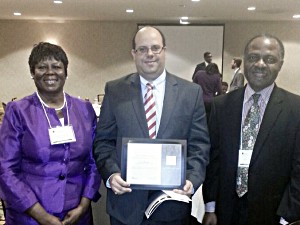FORMER LMRCSC GRADUATE STUDENT EARNED THE COUNCIL OF HISTORICALLY BLACK GRADUATE SCHOOLS CHBGS THESIS AWARD FOR 2016

Hector Malagon, an alumnus of the NOAA LMRCSC at the University of Maryland Eastern Shore (UMES) earned the Council of Historically Black Graduate Schools (CHBGS) ProQuest Thesis Award for 2016 for his thesis, “Population Dynamics of Young of the Year Summer Flounder (Paralichthys dentatus) in Maryland Coastal Bays.” The award was presented to Malagon on February 18 at the Council’s 46thAnnual Conference in Charlotte, NC.
“I have received an extraordinary experience from LMRCSC that I could not have been able to get at another school,” Malagon said. “[The LMRCSC] also provided funds for tuition and helped me to participate in critical extracurricular workshop trainings and international science meetings.”
Malagon currently works as an Environmental Protection Specialist for the US Environmental Protection Agency in Washington, D.C. at the Office of Pollution Prevention and Toxics.
Malagon received his bachelor’s degree in Biology, from University of Havana in 2001. In 2003, he earned a Master of Science degree in Meteorology from the same university. He then decided to move to the United States in 2005. He served in the US Navy for 5 years before joining UMES as part of the in Marine, Estuarine and Environmental Sciences program in September 2012.
Malagon was advised by Paulinus Chigbu, Ph.D., and adopted a specialization in ecology. At that time, Malagon was interested in the benthos community and his goal was to work for the National Oceanic and Atmospheric Administration (NOAA). To align his interests with the mission of NOAA Fisheries, Dr. Chigbu recommended that he pick a fish species for his thesis work. Malagon chose the summer flounder population because it is considered to be one of the most important fish predators on the benthos community.
Specifically, Malagon’s research targeted the young of the year age group for this species and studied the dynamics of this population in Maryland Coastal Bays. He described the seasonal pattern of distribution, abundance and habitat utilization in the bays using Geographic Information System (GIS) and Multivariate statistical methods and software. He also described the dynamic of population parameters such as growth rate, recruitment and mortality for each of the bays and compared them using 23 years of juvenile summer flounder data.
Malagon concluded that “the nursery areas of the fish correspond to sites with relatively low salinity, high temperature and turbidity, muddy/silty substratum, high nutrient levels, and high phytoplankton densities that support high macroinvertebrate prey densities. The critical nursery areas appear to be a very small portion of the bay’s surface area. Perhaps, the recruitment and growth of summer flounder in the bays depend on the spatial extent of these critical nursery areas which may differ among years depending on climate variability that influences freshwater discharge.” A manuscript based on this research has been submitted to the Journal of Sea Research.

